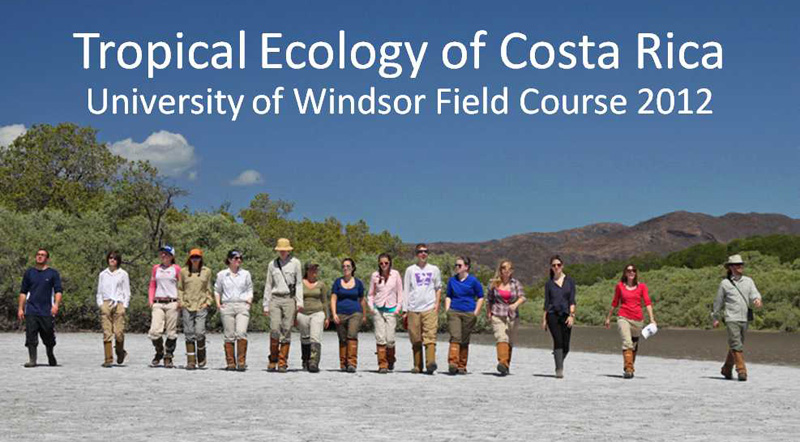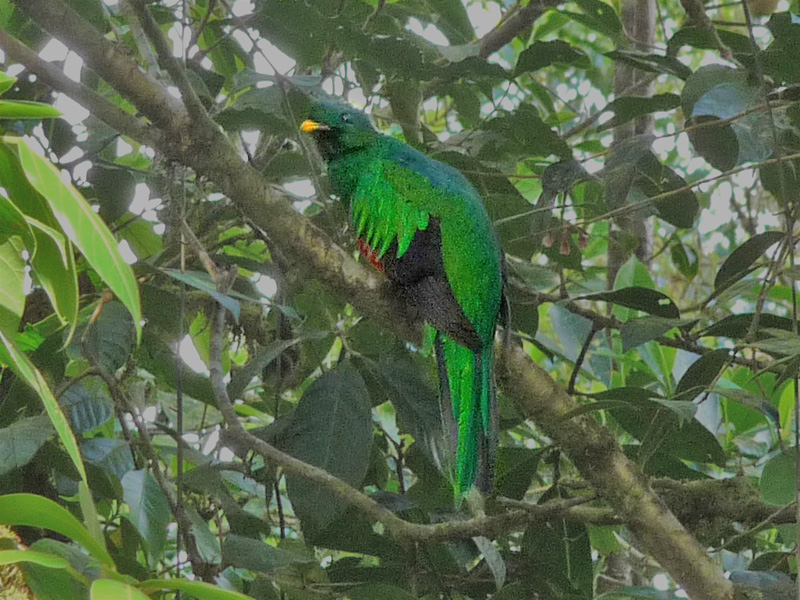|
|
|||||
 |
|||||
|
In
February and March 2012, fourteen
students took part in the University of Windsor's Tropical Ecology of
Costa Rica field course. The course was a hands-on exploration of the
ecology of the tropics including learning activities in the coastal
mangrove forests and low elevation neotropical dry forests of
Guanacaste and montane cloud forests of Monteverde. Follow the
students' experiential learning through this photo album,
featuring photos by the students and professors.
|
|||||
|
|
Watching
the sun rise from the Monument to the Heros in the Guanacaste Conservation Area.
|
|
| Sunrise over the volcaones at the Monument to the Heros, a
monument celebrating Costa Rica's independence. |
|
| Watching Spider Monkeys at La Casona. | Hiking in the Earth's largest remaining stand of neotropical dry forest in the Guanacaste Conservation Area. |
The group poses on the steps inside La Casona, a historic monument inside the Guanacaste Conservation Area. |
||
| Wildlife in the Guanacaste Conservation Area: A White-tailed Deer, a
Pale-billed Woodpecker, a Central American Agouti. |
||
Hiking
in the Humid Forest at Santa Rosa National Park.
|
||
| The students explore the trecherous Boulder Valley in the Humid Forest. | ||
| The group studied three species of monkey in Santa Rosa National Park: Black-handed Spider Monkeys (top left), Montled Howler Monkeys (bottom left), and White-faced Capuchin Monkeys (right). | |
| Birdwatching at the lagoon and mangrove forests at Playa Naranjo in the Guanacaste Conservation Area... in 37C heat! | |
Watching
Mangrove Black Hawks soar over the mangrove forests at Playa Naranjo.
|
||
| Time for a swim in the massive waves at Playa Naranjo. Some
of the waves reached 20 feet. |
||
| Watching wildlife at the coastal lagoon at Playa Naranjo. | |
| |
|
|
| Wildlife in the Guanacaste Conservation Area: a pazel of Pizotes (Long-nosed Coatis), an Owl Butterfly, and a Sac-winged Bat. | ||
| The group hikes to the Jaguar Filming Tower in the Guanacaste Conservation Area. That evening, we watched a documentary filmed in the conservation area on an improvised outdoor movie screen. | |
| The students listen to a presentation by Emily Upham-Mills, a student from last year's field course who is now a monkey researcher working in the Guanacaste Conservation Area. | |
| Moving day: The students load up our field vehicles and drive from the neotropical dry forests of Guanacaste to the montane cloud forests of Monteverde. | |
| A dramatic change in habitat and climate as we arrive at the San Luis Biological Station in Monteverde. | |
| Studying in the library at San Luis Biological Station. | The students deliver evening research seminars. |
| Exploring the plants and animals in the Monteverde Cloud Forest Preserve. | |
| Wildlife of the cloud forest: a Slate-throated Redstart, a Blue-eyed Anole, a Green-crowned Brilliant. | ||
| Studying the cloud forest plants. | Birdwatching from a cloud forest suspension bridge. |
| The group poses in the humid cloud forest on a platform at
the continental divide. The left half of the group is on the Pacific
slope of Costa Rica; the right half of the group is on the Atlantic
slope. |
|
| Hiking along the Rio San Luis to a waterfall. | |
| Crossing foot bridges in the cloud forest en route to the Rio San Luis waterfall. | |
| The group takes an icy plunge into a cloud forest pool. | |
| The 180 feet of the San Luis waterfall. | Hiking on the suspension bridges above the Monteverde cloud forest. |
| The students hike through a series of eight cloud forest suspension bridges. | ||
| A photo from a half-kilometer suspension bridge in the Monteverde cloud forest. | ||
 |
|
| The students spot a Resplendant Quetzal from the suspension bridges. | The group studies butterflies in a cloud forest conservatory. |
| The students conduct independent research projects on the
flora and fauna of the cloud forest. The students' independent projects
were highly varied, including studies of Leaf-cutter Ant foraging
behaviour, the competitive interactions bebtween cloud forest birds,
foraging behaviour of animals on fruiting trees, the biology of
wasp-fig interactions, the influence of aphids on flower morphology,
the development of holes in Monstera leaves, and the responses of
hummingbirds to stinging wasps. |
||
| A closing banquet at the Caburré Argentine Cafe in Monteverde. | The sunset over the San Luis valley and the end of the 2012 field course. |
|
The
faculty and students of the 2012
Tropical Ecology of Costa Rica field course extend their thanks to the
staff of the Guanacaste Conservation Area, particularly Roger Blanco
and the cooks in the the Guanacaste
Conservation Area. See
the Guanacaste
Conservation Area website here.
We thank the staff of San Luis Biological Station, especially Lindsay
Stallcup, Resident Naturalists Kestin and Rebekah, and the cooks in the
San Luis Commedor. See the San Luis website here.
We thank Eladio Castro Mora who gave us excellent transportation
services within Costa Rica; Eladio provides excellent guided tours and
transportation around the Guanacaste area for wildlife watching,
surfing, and acommodation near Liberia; see his flickr site here. Students
interested in field biology courses should visist the Ontario
Universities Program in Field Biology website at www.oupfb.ca. Photos on this website
are by Dan Mennill, Roberto Sosa, and the students on the 2012 Tropical
Ecology Field Course.
|
|
| Return to Dan's Photo Page | Return to Dan Mennill's Homepage |








